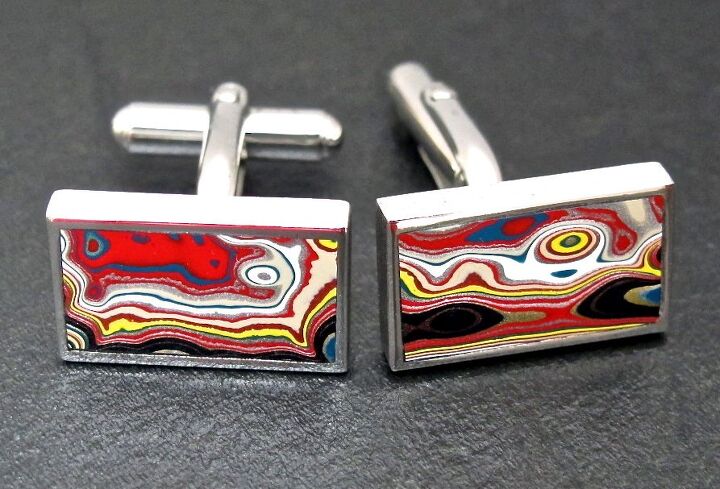Beauty All Around Us: Artists Use Industrial Bi-Product To Make Jewelry
Imagine Detroit at its height, enormous factories and mile-long production lines running day and night, a roiling, churning symphony of man and machine where thousands of workers joined together parts, large and small, from a myriad of sources into single, working vehicle. Although I have toured modern factories in Japan, meticulously clean facilities where technicians in spotless coveralls only complete the tasks that robots cannot, I view the old factories, places like Rouge River that were built in in the first part of the last century, with a special sort of awe. The entirety of what went on there is, to me, unknowable and, like the great pyramids, all that is left of the human toil is the end product. That’s why, when some small piece of history, some bi-product of that mysterious past, catches my attention, I stop and look.
Yesterday, Reddit user “ FissurePrice” posted several images in that website’s photographic sub-forum, r/pics, of something he referred to as “Fordite.” I had never heard of the material, but I was instantly captivated by its bright colors and by the way that skilled hands had taken the raw product and shaped it into jewelry. When I found out that the material, also called “Detroit Agate,” is a bi-product of the automotive manufacturing process it got my full attention.
Fordite, it turns out, is actually countless layers of baked together paint. It is created during the painting process when paint overspray falls upon the various racks and trollies that carry car bodies through a car factory’s paint booth. When the vehicles or their parts are moved into the oven to cure, they remain on the racks and so the overspray hardens and cures in exactly the same way it does on the car body. Once the car moves on, the trollies and racks return to the starting point and repeat the process again and again until the overspray builds up to the point where it must be removed. The result then, are the many layered, oven hardened, chunks of paint you see here.
In the century since cars entered mass production, particular colors have come to the fore, lived in the limelight as the height of fashion and the retreated back into nothingness. Each block of Fordite, then, is like the rings of a petrified tree, capable of telling the story of the environment in which it was originally formed. Different eras have produced different color combinations, the somber colors of the early years, the bright pastels of the ‘50s, the bolder colors of the 60s and 70s, etc and, as a result, different varieties of the material attract different kinds of people.
Not being the kind of person who wears much jewelry, I don’t believe I will ever end up purchasing any Fordite of my own but, because of my interest in both autos and history, I’m happy to see people putting the material to such a creative use. In the same way that people have worked to form natural products into beautiful art, it’s nice to see something man made, something that is technically a waste bi-product, be used in such a way. It just goes to show that beauty and art is all around us, we just need to know where to look.
Thomas Kreutzer currently lives in Buffalo, New York with his wife and three children but has spent most of his adult life overseas. He has lived in Japan for 9 years, Jamaica for 2 and spent almost 5 years as a US Merchant Mariner serving primarily in the Pacific. A long time auto and motorcycle enthusiast he has pursued his hobbies whenever possible. He also enjoys writing and public speaking where, according to his wife, his favorite subject is himself.
More by Thomas Kreutzer
Latest Car Reviews
Read moreLatest Product Reviews
Read moreRecent Comments
- Lou_BC Well, I'd be impressed if this was in a ZR2. LOL
- Lou_BC This is my shocked face 😲 Hope formatting doesn't fook this up LOL
- Lou_BC Junior? Would that be a Beta Romeo?
- Lou_BC Gotta fix that formatting problem. What a pile of bullsh!t. Are longer posts costing TTAC money? FOOK
- Lou_BC 1.Honda: 6,334,825 vehicles potentially affected2.Ford: 6,152,6143.Kia America: 3,110,4474.Chrysler: 2,732,3985.General Motors: 2,021,0336.Nissan North America: 1,804,4437.Mercedes-Benz USA: 478,1738.Volkswagen Group of America: 453,7639.BMW of North America: 340,24910.Daimler Trucks North America: 261,959




































Comments
Join the conversation
What is that fuzzy, carpet-remnanty dark grey stuff running through the middle of that block? I love the stratigraphy of this material. Would love to have some blocks of '50s pastels. Make one into a bowling ball!
A minor quibble, but I think you mean "by-product." Fascinating stuff, though.